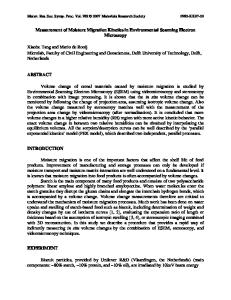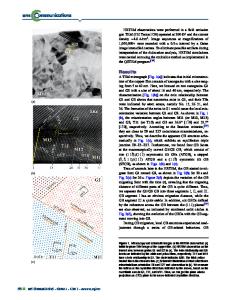High-Resolution Electron Microscopy of Grain Boundary Migration
- PDF / 3,957,362 Bytes
- 12 Pages / 612 x 792 pts (letter) Page_size
- 49 Downloads / 397 Views
High-Resolution Electron Microscopy of Grain Boundary Migration K. L. Merkle, L. J. Thompson and Fritz Phillipp* Materials Science Division, Argonne National Laboratory, Argonne, Illinois 60439, U.S.A. *Max-Planck-Institut für Metallforschung, Heisenbergstr. 1, D-70569 Stuttgart, Germany.
ABSTRACT Atomic-scale grain boundary (GB) migration has been directly observed by high-resolution transmission electron microscopy (HREM). Atomic-scale motion of high-angle tilt GBs as well as twist and general GBs at gold island grains with a number of planar facets has been studied at ambient and elevated temperatures. GB migration mechanisms depend on GB structure and geometry. Strong indications for cooperative effects has been found. In this case, as has been proposed before, atoms may undergo small shifts in their lattice positions to be incorporated into the growing grain in a collective mode. At high temperature and in the absence of a strong driving force such small lattice regions are observed to fluctuate back and forth between the two grains. Faceted GBs typically move in spurts. This appears to be inherent to GB migration, whenever the motion is controlled by different structural entities. For some GB geometries the motion was found to proceed by the lateral propagation of atomic-scale steps. INTRODUCTION Polycrystalline materials routinely are subjected to a variety of processing steps to improve properties by controlling microstructural development. The study of grain boundary migration therefore is an important subject for understanding and controlling microstructure. As evidenced by the contributions to this symposium considerable progress has been achieved recently by the study of controlled GB geometries in bicrystal experiments and by molecular dynamics simulations. Nevertheless, little is known about the underlying atomic-scale migration mechanisms and how GB structure affects mobility [1]. HREM has been an invaluable tool for the study of internal solid interfaces. A great amount of information about the atomic-scale structure of GBs in metals and ceramics has been obtained in this manner [2]. Several in-situ HREM observations of the migration of GBs at ambient temperature have been reported [3-8]. However, in contrast to a number of HREM investigations of heterophase interfaces [9, 10], few HREM observations of GBs at elevated temperature exist [11, 12]. Naturally, there are considerable experimental difficulties in performing well-controlled HREM experiments of high-temperature GB migration . Therefore, to date no quantitative evaluation, for example of GB mobility has been possible with this technique. The direct atomic-scale observation can, nevertheless, provide important information on atomic-scale mechanisms of migration. In general, experimental investigations have to deal with the enormous complexity of the interfacial migration processes which depend not only on grain boundary geometry and thermodynamic quantities, but also on a number of extraneous factors that strongly affect GB mobility, such as
Data Loading...










